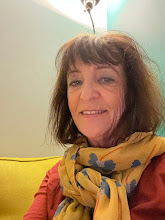At level zero in the Switch House of Tate Modern, far from the hustle and bustle of the main building, The Tanks, a gallery named after its previous use as an oil storage for the power station, deserves a visit to view a display of Giacometti's sculptures. The eleven selected works represent the artist's post WWII period and include one of his surrealist pre-war compositions.
A short passage leads to a dimly lit cavernous earthy colored space with a high ceiling. The sculptures are lined up about one meter from the rough concrete walls, enhanced by the projection of their shadows. Quatres figurines sur pédestal (1950-1965) starts the show. Due to their size, the four statuettes anchored on a thick pedestal of the same bronze set on high legs appear remote, too far for human connections. Giacometti described his torment at the sight of four prostitutes across a room as he shied away from them. About desire, gratification and repulsion, the sculpture hints at his struggle with impotence due to a bout of mumps during his adolescence. The very personal work is followed by two elongated, emaciated, naked figures, the taller androgynous (Grande figure II 1948-9) and the other female (Femme de Venise IX 1956), characteristic of his post-war style. Three busts set on pedestals next to each other emphasize another side of Giacometti's practice. Buste of Diego (1955) made from memory is about his brother, his preferred model. Buste d'Annette IV (1962) one of a series of eight features his wife and Buste d'homme (dit Chiavenna I) (1954) is a rare bust of an unknown sitter. The horrors of the war did impact Giacometti profoundly and inspired three small sculptures of maimed females (c. 1958) with broken and missing limbs set on a stand. They also reflect the influence of Cycladic and Egyptian art with their hieratic postures, long necks and legs. In the middle of the room, Homme qui pointe (1947) casting its shadow on the floor could not find a better setting under a discreet spotlight. Of human size, skeletal but solidly anchored on two feet and legs spread on a base, Man Pointing aims an accusing finger to the empty space on his right side. Clearly the sculpture refers to the victims of the Second World War. It also becomes a symbol for all victims of war and implies a universal guilt. Still haunted by the last work, on the way out, I almost missed a sculpture nestled in a small rotunda. In the center, on top of a pedestal-altar, L'Heure des Traces (1932) is the only work from Giacometti's surrealist period in the exhibit: a heart in a cage and above, a walking stick-like figure crossed by a reclining stylized female shape, like a 3D drawing, floating in space, a gateway to the world of dreams and the subconscious.
The show which appears modest at first, gives a valuable insight into Giacometti's career with a sample of his works gathered in the fittingly bare industrial space. Of Swiss origin, Alberto Giacometti (1901-1966) moved to Paris in 1922. While living in the French capital, he mingled with intellectuals and artists and, as he became close to André Breton and his entourage, adopted surrealism and abstraction in his practice which turned back to the model and figuration around 1935. Following a lull in his creativity during the war spent in Switzerland, he became famous in the fifties and sixties with his sculptures of walking men, standing women, and portraits of family and friends. The slowdown in productivity during the war was also marked by his miniature sculptures (as small as matches) reduced literally to bones, almost vanishing, Giacometti's way of rendering distance, alienation, loneliness. Homme qui Pointe made "in one night between midnight and nine the next morning" according to the artist, illustrates the spontaneous gesture of the sculptor who stated: "For years, I have made the sculptures that have offered themselves, already finished, to my spirit; I have limited myself to reproducing them in space, without changing anything about them, without wondering what they might signify." Shunning abstraction, conceptual art or art movements, he adopted a more philosophical outlook to his practice as upon his return to Paris, he grew a close friendship with Jean Paul Sartre, beacon of existentialism. In 1948 Sartre wrote "The Quest for the Absolute", an essay for the catalogue of Giacometti's exhibition at the Pierre Matisse Gallery in New York City and the author of "Being and Nothingness" reviewed Giacometti's work... until their irreparable fall-out. In one of his insightful comments about Giacometti's sculptures he described "these moving approximations, still halfway between nothingness and being, still in the process of modification, improvement, destruction, and renewal, assumed an independent, definitive existence."
In the semi-obscurity, the bronze sculptures enhanced by their ghostly shadows are coming alive under the spotlights bathing their scarred surface. The scenographic setting allows the visitor to feel a deep connection with the works, triggering thoughts and emotions. It offers mainly a frontal view of the sculptures and the wall texts fail to provide their size, however size becomes irrelevant. The sculptures shrink and grow as we walk back and forth in front of them and experience distance and nearness. The silence adds a sepulchral aura to the space and a wish from Giacometti comes to mind: " If I were true to myself, I'd bury all my sculptures so that they wouldn't be found for a thousand years." The show could be entombed in the bowels of Tate Modern for centuries, Giacometti's rediscovered works would be as pertinent as they are today. Human condition is a universal, timeless subject.

























